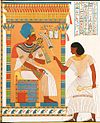Haty-a
| Haty-a in hieroglyphs | ||||
|---|---|---|---|---|
Ḥaty-a | ||||
Ḥaty-a was an ancient Egyptian rank and title given to local princes, mayors, or governors.[1] There is no standard translation for it, and it is frequently left transliterated in scholarly literature. In strings of ranking titles Ḥaty-a most often appears between the ranking titles iry-pat and khetemty-bity (royal sealer) and was therefore a sign of an extremely high status in the ranking of officials in Ancient Egypt. As mayor, the title often stands alone in inscription in front of the name, but was also often combined with the titles overseer of priests or overseer of the god's house, indicating that local governors were also the head of local religious matters.[2]
References
- ^ Gardiner, Alan Henderson (1957). Egyptian Grammar; Being an Introduction to the Study of Hieroglyphs (3rd ed.). Oxford: Griffith Institute, Ashmolean Museum. p. 51. ISBN 0 900416 351.
- ^ S. Quirke: Titles and bureaux of Egypt 1850-1700 BC, London 2004, ISBN 0954721802, 111-112

